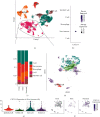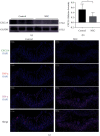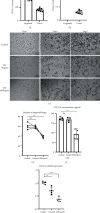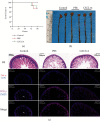Reduced Incidence of Necrotizing Enterocolitis due to the Anti-Inflammatory Effects of CXCL14 in Intestinal Tissue
- PMID: 35463668
- PMCID: PMC9023168
- DOI: 10.1155/2022/1322172
Reduced Incidence of Necrotizing Enterocolitis due to the Anti-Inflammatory Effects of CXCL14 in Intestinal Tissue
Retraction in
-
Retracted: Reduced Incidence of Necrotizing Enterocolitis due to the Anti-Inflammatory Effects of CXCL14 in Intestinal Tissue.J Healthc Eng. 2023 Oct 4;2023:9824205. doi: 10.1155/2023/9824205. eCollection 2023. J Healthc Eng. 2023. PMID: 37829427 Free PMC article.
Abstract
Bioinformatic analysis indicated that downregulated CXCL14 will occur in the intestinal tissue of patients with necrotizing enterocolitis (NEC). To reveal the relationship between CXCL14 and mucosal immune regulation, we designed and implemented the experiments to explore the potential function of CXCL14 in the pathogenesis of NEC. Firstly, this study confirmed that the expression of CXCL14 decreased in the intestinal tract of NEC children. Secondly, the experiments results showed that CXCL14 could ameliorate the inflammatory injury of intestinal tissue through the suppressive effect on the expression of TNF-α and INF-γ in vivo. Finally, we explained that activation of the TLR4 can reduce the expression level of CXCL14 in the intestinal tissue of mouse pups. Collectively, our study suggested that CXCL14 may negatively regulate the inflammatory response in intestinal tissue and play an essential role in NEC development and progression.
Copyright © 2022 Xu Sun et al.
Conflict of interest statement
The authors declare that there are no conflicts of interest.
Figures





Similar articles
-
Prenatal inflammation impairs intestinal microvascular development through a TNF-dependent mechanism and predisposes newborn mice to necrotizing enterocolitis.Am J Physiol Gastrointest Liver Physiol. 2019 Jul 1;317(1):G57-G66. doi: 10.1152/ajpgi.00332.2018. Epub 2019 May 24. Am J Physiol Gastrointest Liver Physiol. 2019. PMID: 31125264 Free PMC article.
-
Tumor necrosis factor-alpha and apoptosis signal-regulating kinase 1 control reactive oxygen species release, mitochondrial autophagy, and c-Jun N-terminal kinase/p38 phosphorylation during necrotizing enterocolitis.Oxid Med Cell Longev. 2009 Nov-Dec;2(5):297-306. doi: 10.4161/oxim.2.5.9541. Oxid Med Cell Longev. 2009. PMID: 20716917 Free PMC article.
-
Oral administration of surfactant protein-a reduces pathology in an experimental model of necrotizing enterocolitis.J Pediatr Gastroenterol Nutr. 2015 May;60(5):613-20. doi: 10.1097/MPG.0000000000000678. J Pediatr Gastroenterol Nutr. 2015. PMID: 25539191 Free PMC article.
-
Potential role of bile acids in the pathogenesis of necrotizing enterocolitis.Life Sci. 2024 Jan 1;336:122279. doi: 10.1016/j.lfs.2023.122279. Epub 2023 Nov 22. Life Sci. 2024. PMID: 37995935 Review.
-
Intestinal microcirculatory dysfunction and neonatal necrotizing enterocolitis.Chin Med J (Engl). 2013;126(9):1771-8. Chin Med J (Engl). 2013. PMID: 23652066 Review.
Cited by
-
Retracted: Reduced Incidence of Necrotizing Enterocolitis due to the Anti-Inflammatory Effects of CXCL14 in Intestinal Tissue.J Healthc Eng. 2023 Oct 4;2023:9824205. doi: 10.1155/2023/9824205. eCollection 2023. J Healthc Eng. 2023. PMID: 37829427 Free PMC article.
References
Publication types
MeSH terms
Substances
LinkOut - more resources
Full Text Sources

